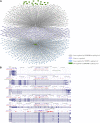DNA- and RNA-Binding Proteins Linked Transcriptional Control and Alternative Splicing Together in a Two-Layer Regulatory Network System of Chronic Myeloid Leukemia
- PMID: 36052164
- PMCID: PMC9425088
- DOI: 10.3389/fmolb.2022.920492
DNA- and RNA-Binding Proteins Linked Transcriptional Control and Alternative Splicing Together in a Two-Layer Regulatory Network System of Chronic Myeloid Leukemia
Abstract
DNA- and RNA-binding proteins (DRBPs) typically possess multiple functions to bind both DNA and RNA and regulate gene expression from more than one level. They are controllers for post-transcriptional processes, such as splicing, polyadenylation, transportation, translation, and degradation of RNA transcripts in eukaryotic organisms, as well as regulators on the transcriptional level. Although DRBPs are reported to play critical roles in various developmental processes and diseases, it is still unclear how they work with DNAs and RNAs simultaneously and regulate genes at the transcriptional and post-transcriptional levels. To investigate the functional mechanism of DRBPs, we collected data from a variety of databases and literature and identified 118 DRBPs, which function as both transcription factors (TFs) and splicing factors (SFs), thus called DRBP-SF. Extensive investigations were conducted on four DRBP-SFs that were highly expressed in chronic myeloid leukemia (CML), heterogeneous nuclear ribonucleoprotein K (HNRNPK), heterogeneous nuclear ribonucleoprotein L (HNRNPL), non-POU domain-containing octamer-binding protein (NONO), and TAR DNA-binding protein 43 (TARDBP). By integrating and analyzing ChIP-seq, CLIP-seq, RNA-seq, and shRNA-seq data in K562 using binding and expression target analysis and Statistical Utility for RBP Functions, we discovered a two-layer regulatory network system centered on these four DRBP-SFs and proposed three possible regulatory models where DRBP-SFs can connect transcriptional and alternative splicing regulatory networks cooperatively in CML. The exploration of the identified DRBP-SFs provides new ideas for studying DRBP and regulatory networks, holding promise for further mechanistic discoveries of the two-layer gene regulatory system that may play critical roles in the occurrence and development of CML.
Keywords: DNA- and RNA-binding protein; alternative splicing regulatory network; chronic myeloid leukemia; splicing factor; transcription factor; transcriptional regulatory network.
Copyright © 2022 Wang, Zong, Wu, Leung, Hu and Qin.
Conflict of interest statement
The authors declare that the research was conducted in the absence of any commercial or financial relationships that could be construed as a potential conflict of interest.
Figures








References
-
- Andersson M. K., Ståhlberg A., Arvidsson Y., Olofsson A., Semb H., Stenman G., et al. (2008). The Multifunctional FUS, EWS and TAF15 Proto-Oncoproteins Show Cell Type-specific Expression Patterns and Involvement in Cell Spreading and Stress Response. BMC Cell. Biol. 9, 37. 10.1186/1471-2121-9-37 - DOI - PMC - PubMed
-
- Bailey T. L., Elkan C. (1994). Fitting a Mixture Model by Expectation Maximization to Discover Motifs in Biopolymers. Proc. Int. Conf. Intell. Syst. Mol. Biol. 2, 28–36. - PubMed
LinkOut - more resources
Full Text Sources
Miscellaneous

